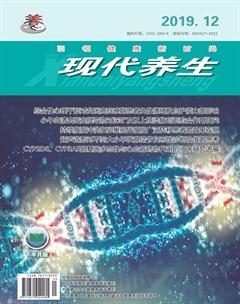淺談腺樣體肥大發病機制
曾小燕 馬玲國
【摘 要】人類咽淋巴組織在機體對呼吸道病原體的免疫應答中起著重要的作用,腺樣體是咽淋巴環的一部分,在一些感染性和非感染性上呼吸道疾病中起作用。腺樣體肥大可能與中耳炎、鼻竇炎、扁桃體炎和支氣管炎等疾病有關。現階段對于腺樣體肥大的發病機制未明確,本文從多方面綜述其可能發病機制,對進一步了解其致病及診治有重要的臨床意義。
【關鍵詞】腺樣體肥大;微生物;免疫;機制
1 腺樣體肥大與微生物
細菌感染目前被認為是兒童腺樣體肥大及其反復發作的主要原因,同時腺樣體表面駐留大量的微生物,這些微生物刺激腺樣體組織產生免疫反應可能是導致腺樣體肥大的主要原因。[1][2] 通過對腺樣體細菌學的研究,發現腺樣體存在大量的致病菌,包括金黃色葡萄球菌、卡他莫拉菌、流感嗜血桿菌和鏈球菌等,腺樣體被認為是病細菌的儲蓄池。[3]反復炎癥刺激引起一系列的免疫應答反應,成為腺樣體肥大的原因。鼻腔、咽喉、扁桃體等腺樣體周圍組織的炎癥擴散,也可能是引起腺樣體肥大的病因。因此,研究兒童腺樣體肥大的細菌感染情況及菌種分布情況對腺樣體肥大的病理生理、發病原因及臨床診治均具有重要的指導意義。
此外,許多研究[4-7]已表明包括病毒感染在內的呼吸道疾病患者的鼻咽微生物的多樣性和豐富度降低,呼吸道疾病患者的鼻咽致病菌數量增加,包括金黃色葡萄球菌、肺炎鏈球菌、卡他莫拉菌和流感嗜血桿菌等[8]。
2 腺樣體肥大與免疫
咽淋巴環的淋巴上皮器官在對各種消化和呼吸抗原的區域免疫反應中起作用。這些器官參與一系列的免疫過程,從記憶B細胞的擴展和終末分化到作為細胞介導的免疫反應的誘導位點。[9][10]許多研究已經描述了與扁桃體或腺樣體肥大、感染或阻塞性睡眠呼吸暫停相關的細胞組成或功能因子(細胞因子、模式識別受體)表達的特殊變化。區域性微生物暴露與器官的內在免疫微環境之間的相互影響可能導致宿主細胞的歸巢、成熟和激活的差異。[11]
研究表明完整的先天免疫和T細胞介導的免疫,特別是T輔助細胞的Th17亞群,似乎是有效清除鼻咽定植所必需的[12][13][14]。當T細胞免疫受到影響時,鼻咽定植的清除就會受到損害[12]。
3 腺樣體肥大與面部結構
細微的(亞臨床/非綜合征)面部結構變異一直被認為是口腔呼吸的潛在來源。[9][15]此外,Zicari[15]和Guilleminault[17]認為,鼻塞和骨骼變異本身可能是通過口呼吸的粘膜刺激刺激腺扁桃體生長的主要刺激因素。傳統觀點認為腺樣體肥大是面部畸形的起源,這種觀點在正畸學文獻中非常突出。這一概念背后的許多證據來源于上世紀80年代對猴子的小規模研究。[18][19]對這些恒河猴的鼻阻塞只會導致面部長度的變化,而面部長度只是肌肉骨骼對慢性口呼吸的適應。然后Stupak等提出不同的觀點,他們提出一個機械線性假說解釋了面部結構問題、腺樣體肥大和慢性口呼吸三者之間的關聯關系,總結其順序為:1)上頜/下頜結構變異/大小限制→易發生鼻阻塞和口呼吸,2)鼻咽負壓力→咽淋巴環中粘膜壁應力下降,3)因腔內粘膜伸展并失去彈性而導致的反復組織微血腫,→4)最終黏膜下炎癥伴淋巴樣肥大。5)對慢性口呼吸的適應,導致張口閉合肌群平衡的改變。[20]
4 腺樣體肥大與呼吸道粘膜清除率
有研究發現,在腺樣體肥大和分泌性中耳炎的感染情況下,粘蛋白相關因素可能影響粘膜特性和鼻MCC(粘膜纖毛清除率)。Maurizi等人用掃描電鏡觀察腺樣體組織的變化,并觀察鼻部MCC隨年齡的變化。無腺樣體肥大患者鼻MCV(粘膜纖毛清除速率)隨年齡增加而增加,10歲時接近成人值。但與腺樣體大小相關,腺樣體肥大患者鼻MCV明顯受損。在超微結構的比較中,腺樣體肥大患者最常見的是纖毛的缺失,或幾乎很少具有代表性的纖毛(“島狀”結構),在粘膜表面不均勻分布。他們將這些變化與黏膜表面的炎癥和腺樣體肥大所致的梗阻聯系起來[21]。Arnaoutakis等人報道了兒童腺樣體切除術后MCC和MCV的改善,說明癥狀學與鼻MCC改變的相關性。他們發現,患者的癥狀與鼻黏膜纖毛功能障礙、機械阻塞、腺樣體細菌蓄積作用以及由此產生的粘液滯留有關。此外,他們認為,治療鼻腔阻塞,清除細菌池和可能出現的生物膜,可恢復鼻腔正常的MCC和pH值增加[22]。
(通信作者:曾小燕)
參考文獻
[1]Sawatsubashi M,Murakami D,Umezaki T,et al.Endonasalendoscopic surgery with combined middle and inferior meatalantrostomies for fungal maxillary sinusitis.J Laryngol Otol,2015,129 Suppl 2:S52-S55.
[2]Ren T,Glatt DU,Nguyen TN,et al.16s rRNA survey revealed complex bacterial communities and evidence of bacterial interference on human adenoids[J].Environ Microbiol ,2013,15(2):535-547.
[3]Barambilla I,Pusateri A,Pagella F,et al.Adenoids in children:Advances in immunology,diagnosois,and surgery[J].Clinanat, 2014,27(3):346-352.
[4]Yi H, Yong D, Lee K, et al. Profiling bacterial community in upper respiratory tracts. BMC Infect Dis 14:583.BMC Infect Dis.2014 Nov 13 ;14 :583.DOI:10.1186/s12879-014-0583-3.
[5]De Steenhuijsen Piters WA, Huijskens EG, Wyllie AL, et al.Dysbiosis of upper respiratory tract microbiota in elderly pneumonia patients. ISME J.2016 Jan;10(1):97-108DOI:10.1038/ismej.2015.99.
[6]Korten I, Mika M, Klenja S, et al. Interactions of respiratory viruses and the nasal microbiota during the first year of life in healthy infants. mSphere.2016;1(6).DOI:10.1128/mSphere. 00312-16.
[7]Ederveen THA, Ferwerda G, Ahout IM, et al. Haemophilusis overrepresented in the nasopharynx of infants hospitalized with RSV infection and associated with increased viral load and enhanced mucosal CXCL8 responses. Microbiome.2018 01 11;6(1):10.DOI:10.1186/s40168-017-0395-y.
[8]Skevaki CL, Tsialta P, Trochoutsou AI, et al. Associations between viral and bacterial potential pathogens in the nasopharynx of children with and without respiratory symptoms. Pediatr Infect Dis J.2015 Dec;34(12):1296-301DOI:10.1097/INF.0000000000000872.
[9]Brandtzaeg, P. (2010). Function of mucosa-associated lymphoid tissue in antibody formation. Immunol Invest, 39(4-5), 303-355.
[10]Kato, A., Hulse, K. E., Tan, B. K., & Schleimer, R. P. (2013). B-lymphocyte lineage cells and the respiratory system. J Allergy Clin Immunol, 131(4), 933-957; quiz 958.
[11]Randall, T. D., & Mebius, R. E. (2014). The development and function of mucosal lymphoid tissues: a balancing act with micro-organisms. Mucosal Immunol, 7(3), 455-466.
[12]van Rossum AM, Lysenko ES, Weiser JN. Host and bacterial factors contributing to the clearance of colonization by Streptococcus pneumoniae in a murine model. Infect Immun.2005 Nov ;73(11):7718-26.DOI:10.1128/IAI.73.11.7718-7726.2005.
[13]Malley R, Trzcinski K, Srivastava A, et al. CD4+ T cells mediate antibody independent acquired immunity to pneumococcal colonization.Proc Natl Acad Sci U S A.2005 Mar29 ;102(13):4848-53.DOI:10.1073/pnas.0501254102.
[14]Lu YJ, Gross J, Bogaert D, et al. Interleukin-17A mediates acquired immu nity to pneumococcal colonization. PLoS Pathog. 2008;4:e1000159.DOI:10.1371/journal.ppat.1000159.
[15]40. Price, W. Nutrition and Physical Degeneration: A Comparison of Primitive and Modern Diets and Their Effects". J Am Med Assoc. 114 (26): 2589. 29 June 1940.
[16]41. Zicari AM, Marzia D, Occasi F Cephalometric Pattern and Nasal Patency in Children with Primary Snoring: The Evidence of a Direct Correlation PLoS One. 2014; 9(10): e111675.
[17]42. Guilleminault C, Akhtar F. Pediatric sleep-disordered breathing: New evidence on its development. Sleep Med Rev. 2015 Dec;24:46-56.
[18]5. Harvold EP, Tomer BS, Vargervik K, Chierici G. Primate experiments on oral respiration. Am J Orthod. 1981 Apr;79(4):359-72.
[19]6. Tomer BS, Harvold HP. Primate experiments on mandibular growth direction. Am J Orthod. 1982 Aug;82(2):114-9.
[20]Stupak, HD; Park, SY; Gravitational forces, negative pressure and facial structure in the genesis of airway dysfunction during sleep: a review of the paradigm.Sleep Med.2018 11;51:125-132 DOI:10.1016/j.sleep.2018.06.016
[21] 7.Maurizi M, Ottaviani F, Paludetti G, Almadori G, Zappone C.Adenoid hypertrophy and nasal mucociliary clearance in children.A morphological and functional study. Int J Pediatr Otorhinolaryngol. 1984;8(1):31–41.
[22]8. Arnaoutakis D, Collins WO. Correlation of mucociliary clearance and symptomatology before and after adenoidectomy in children.Int J Pediatr Otorhinolaryngol. 2011;75(10):1318–21. doi:10.1016/j.ijporl.2011.07.024.

